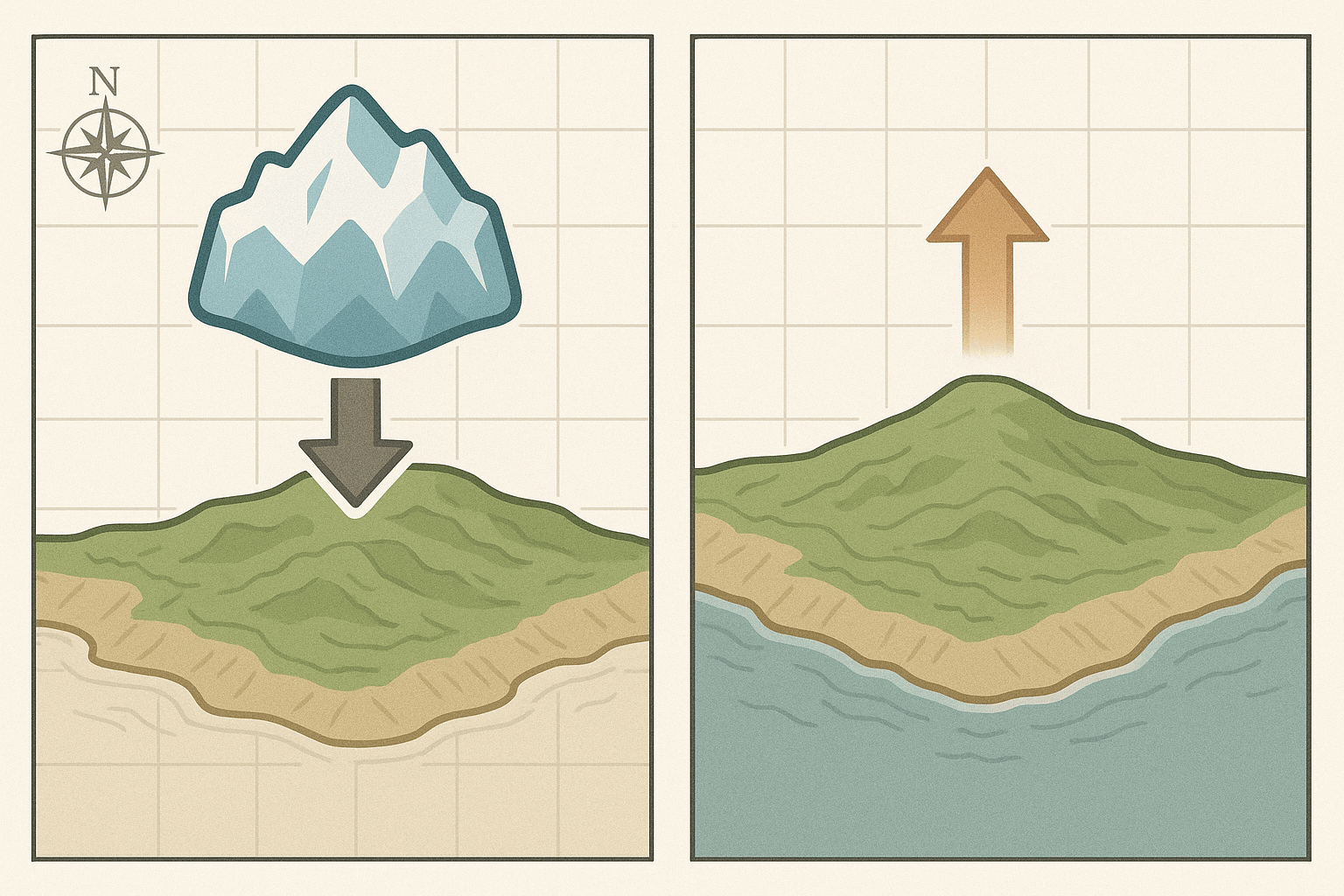What is Glacial Rebound? The Planet’s Slow Recovery
To understand why continents are rising, we have to travel back in time to the Last Glacial Maximum, around 20,000 years ago. During this period, vast ice sheets, some up to three kilometers thick, covered huge swathes of North America and Eurasia. The sheer weight of this ice was astronomical.
Imagine placing a heavy bowling ball on a memory foam mattress. The mattress sinks under the weight. The Earth’s crust, while seemingly rigid, behaves similarly over geological timescales. It floats on a hot, semi-fluid layer of the upper mantle called the asthenosphere. The immense pressure from the ice sheets pushed the crust down, depressing it into the mantle much like the bowling ball on the mattress. The land under modern-day Canada, Scandinavia, and Siberia was suppressed by hundreds of meters.
Then, as the climate warmed and the ice sheets began to melt, that colossal weight was removed. Just as the memory foam mattress slowly returns to its original shape after the bowling ball is lifted, the Earth’s crust began to “rebound” upwards. This process, however, is incredibly slow because the mantle material (the “foam”) is extremely viscous and takes a long time to flow back into place. The rebound that started over 10,000 years ago is still happening today.
A Tour of Post-Glacial Hotspots
The effects of this rebound are not uniform across the globe. They are most pronounced in the regions that once lay at the heart of the great ice sheets.
Scandinavia: The Rising Coastline
The Fennoscandian Shield, which covers Finland, Sweden, Norway, and parts of Russia, is a classic example of glacial rebound. The fastest uplift is occurring around Sweden’s High Coast (Höga Kusten) on the Gulf of Bothnia. This area, a UNESCO World Heritage site precisely because of this phenomenon, is rising at a rate of nearly one centimeter per year.
The consequences are profound and visible:
- New Islands: Small islets, known as skerries, are constantly emerging from the sea. Land that was once the seabed becomes coastline, and coastlines become inland fields.
- Shifting Harbors: The city of Luleå, Sweden, has had to move its harbor multiple times over the centuries as the rising land made the old ports too shallow for ships.
- Viking History Revealed: Viking-era harbors and boathouses that were once on the water’s edge are now found several hundred meters inland, providing archaeologists with perfectly preserved snapshots of the past.
North America: The Hudson Bay Bulge
Across the Atlantic, a similar story is unfolding. North America was once home to the massive Laurentide Ice Sheet, centered over what is now Hudson Bay. Today, the land around the bay is rising dramatically. In places like Churchill, Manitoba—famous for its polar bears—the land is rising by more than a centimeter per year.
This uplift affects the entire Great Lakes region, causing the lakes to slowly tilt. The northern shores are rising while the southern shores, like those near Chicago and Cleveland, are effectively subsiding relative to the lake levels, increasing erosion and flood risk.
The Other Side of the Coin: The Collapsing Forebulge
Glacial rebound is not just about land rising; it’s also about land sinking. When the ice sheets pushed the crust down, the displaced mantle material had to go somewhere. It flowed outwards, causing the land at the periphery of the ice sheets to bulge upwards. This is known as a “glacial forebulge.”
Now that the ice is gone and the mantle is flowing back towards the center of the depression, that forebulge is slowly collapsing. This means that areas that were once lifted up are now sinking.
A prime example is the East Coast of the United States. Cities from Washington D.C. down to the Carolinas are experiencing land subsidence partly because they sit on this collapsing forebulge. This sinking effect combines with global sea-level rise, dramatically increasing the vulnerability of coastal communities to flooding and shoreline erosion. The Chesapeake Bay is a stark illustration of this double-whammy, where sinking land exacerbates rising seas.
Reshaping Human Geography
This slow-motion geological process has tangible impacts on human life and society. In Finland and Sweden, the concept of “new land” is legally recognized. As the coastline extends, farmers can claim new, fertile soil that emerges from the sea, literally expanding their property over generations.
Conversely, the maintenance of coastal infrastructure becomes a constant challenge. Ports need to be dredged, lighthouses become stranded inland, and drainage patterns for entire regions are altered, affecting agriculture and ecosystems. It’s a powerful reminder that even our most permanent maps are just a snapshot in time.
A Window into Earth’s Interior
Beyond its direct impact on the surface, studying glacial rebound provides scientists with a unique tool to understand our planet. The speed of the rebound is directly related to the viscosity of the Earth’s mantle. By measuring the rate of uplift with GPS and other satellite technologies, geophysicists can calculate how “thick” or “runny” the mantle is—a crucial property for understanding plate tectonics, volcanism, and the Earth’s internal heat flow.
Furthermore, it helps climatologists disentangle local, relative sea-level changes from the global average. When a tide gauge in Stockholm shows the sea level is falling, scientists know it’s primarily because the land is rising, allowing them to create a more accurate picture of global sea-level rise caused by melting glaciers and thermal expansion of ocean water.
The story of glacial rebound is a fascinating intersection of past, present, and future. It’s a geological echo of a frozen world, a dynamic force shaping our coastlines, and a scientific key unlocking secrets of the deep Earth. The next time you stand on a shore in Scandinavia or near Hudson Bay, take a moment. The solid ground you’re on is not so solid after all—it’s on a journey, rising slowly but surely toward the sky.
